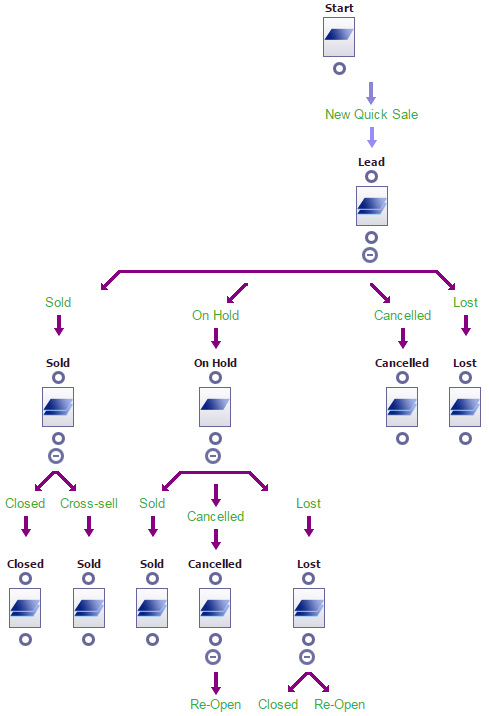About workflow

Workflow automates business processes using a predefined set of business rules and actions. A workflow guides the user through a business process, checking, tracking, and validating information, and triggering actions. It's a great way to reduce administration overhead, ensure consistency, and benchmark performance.
For example, you could apply a workflow rule to opportunities to automatically generate a follow-up call whenever a quote is issued to a customer. Or you could apply a workflow rule to cases to send an email to the customer service supervisor if a case remains at the Investigating stage for more than twenty-four hours.
You can apply workflow to company, person, communication, lead, opportunity, case, solution, campaign, wave, and wave item records. You can also apply workflow to custom entities. To apply workflow to an external table, you must create a shadow table in Sage CRM. The data is retrieved from the external table in the ASP pages associated with the workflow rules. For more information, see the Developer Help on the Sage CRM Help Center.
A workflow consists of states, rules, and actions.
- A state is the current resting place for a record in the workflow process. The user sees a predefined set of business actions based on the record's current state in the workflow. For more information, see Workflow states.
- A rule determines the actions that are performed on the record in a specific state and often move the record to another state. For more information, see Workflow rules.
- An action is the execution of the rule when the user selects the workflow rule, or when conditions are met to validate the rule. For more information, see Workflow actions.
Sage CRM has a graphical workflow tree that uses loops and branches and lets you view a visual representation of the states and rules in your workflow as you build it.
Setting up workflow
|
Task |
Help |
|---|---|
|
Conduct an analysis of your business processes and produce a flow diagram that outlines your workflow and lists the actions you need. |
For sample questions to help you identify your business processes, see the Implementation Workbook on the Sage CRM Help Center. |
|
Enable your system for workflow and activate workflow for the required entities. |
|
|
Complete all field, list, and screen customizations. |
|
|
Customize the Stage and Status list selections for opportunities, cases, leads, and solutions if necessary. These fields often help define the state of a record at different points in the workflow. Adding more selections to these fields does not affect existing workflows unless you explicitly build in behavior to use the new selections. Do not delete list selections because the workflow relies on the In Progress status. Rename the translations for list selections instead. |
|
|
Check the GIF files. If you change the Stage and Status lists, you may lose the GIF file representation of the values. To fix this, edit or update the GIF file in the Img subdirectory of Sage CRM. The GIF file name must exactly match the untranslated code of the list selection. |
|
Building a workflow
|
Task |
Help |
|---|---|
|
Create a new workflow using the graphical workflow tree. |
Creating a workflow |
|
Create workflow states. |
Creating a workflow state |
|
Create workflow rules and add actions to the rules. |
Creating a workflow rule |
|
Add states and rules to the workflow and activate the workflow so you can test it and then make it available to users. |
